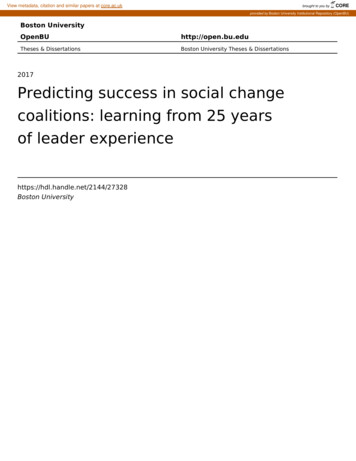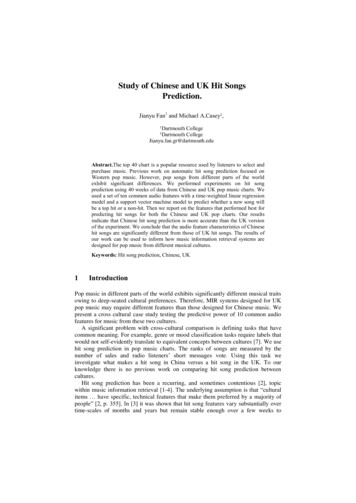
Transcription
View metadata, citation and similar papers at core.ac.ukbrought to you byCOREprovided by Boston University Institutional Repository (OpenBU)Boston UniversityOpenBUhttp://open.bu.eduTheses & DissertationsBoston University Theses & Dissertations2017Predicting success in social changecoalitions: learning from 25 yearsof leader experiencehttps://hdl.handle.net/2144/27328Boston University
BOSTON UNIVERSITYGRADUATE SCHOOL OF ARTS AND SCIENCESDissertationPREDICTING SUCCESS IN SOCIAL CHANGE COALITIONS:LEARNING FROM 25 YEARS OF LEADER EXPERIENCEbyJESSICA CHAMBERLAIN GREENAWALTB.A., Boston University, 2004MSW, California State University, East Bay, 2008Submitted in partial fulfillment of therequirements for the degree ofDoctor of Philosophy2017
2017 byJESSICA CHAMBERLAIN GREENAWALTAll rights reserved
Approved byFirst ReaderScott Miyake Geron, Ph.D.Research Associate Professor for Social Welfare PolicySecond ReaderEmily A. Barman, Ph.D.Associate Professor of SociologyThird ReaderMelvin Delgado, Ph.D.Professor of Macro Practice
DEDICATIONI lovingly dedicate this work to my daughter, Francesca Philomena, who inspires me tobe the role model she deserves. Yes, Baby - THIS is girl power.iv
ACKNOWLEDGEMENTSI’d like to acknowledge all of people who supported me in the journey of completing thiswork.I’d like to first acknowledge my committee. Much gratitude is expressed for Scott Geron,who has acted as my professor, employer, advisor, guide and advocate, and whom I ameternally grateful for. Also, to Emily Barman, who has provided invaluable feedback andintellectual support and who helped to strengthen this work. I’d also like to thank MelvinDelgado for jumping on board to support me in the final stages of this project. Lastly, I’dlike to thank Lee Staples, who has served as my mentor and advisor and who inspires meto carve my own place as a social worker, organizer and academic.I’d also like to acknowledge Sally Bachman and Ellen Devoe for the emotional andpractical support given during my most discouraging of times. Lastly, I’d like to thankPeg Tamiso for administrative support in this process.I’d also like to gratefully acknowledge Terry Mizrahi, who has mentored meprofessionally and personally, as well as Beth Rosenthal – both of whom generouslyturned over their data so I could complete my work.I’d also like to show my gratitude to my family – especially my parents - who haveshown unwavering practical, emotional and financial support in my academic pursuitsand beyond.v
I want to also acknowledge Michael Rice, who’s motivated and encouraged me since theday we met and whom I love from the bottom of my heart.I’d also like to thank Ruben Martinez, whose co-parenting I relied upon in the final stagesof this work and who supported me from the beginning of this project.Lastly, I want to thank the crew at Darling Coffee. Thanks for keeping me accountableand fueled through the most exhausting of times.THANK YOU!vi
PREDICTING SUCCESS IN SOCIAL CHANGE COALITIONS:LEARNING FROM 25 YEARS OF LEADER EXPERIENCEJESSICA CHAMBERLAIN GREENAWALTBoston University, Graduate School of Arts and Sciences, 2017Major Professor: Scott Miyake Geron, Research Associate Professor for Social WelfarePolicyABSTRACTThis dissertation builds upon a 25-year old study by Mizrahi and Rosenthal(1993) which examined how coalition leaders defined and perceived success and failurein their respective coalitions. This study replicates the Mizrahi and Rosenthal study byreturning to participants from the original study and, adapting the original instrument,interviewing those participants to examine their perceptions after 25 years has passed.Utilizing the same instrument, new coalition leaders from the originally studied coalitionswhich are still intact are also interviewed and their responses are compared againstresponses from leaders of coalitions which have since dissolved. The current study usesbasic descriptive analysis for the structured survey items and grounded theorymethodology for the qualitative analysis of open-ended questions.The analysis examines participant responses in the following areas: participantinformation; coalition information; demographic information of working group, boardand constituency; characterization of coalition; internal and environmental predictors ofdissolution; political and social climate during dissolution; political forces influencingdissolution; events in the lifespan; benefits and drawback of permanency; targetinformation; definition of success; internal and environmental predictors of success;vii
goals; strategies and tactics; decision-making processes; modes of communication;coalition resources; membership and participation; leadership; and practice wisdom.Utilizing organizational, ecological, social capital and collaboration literature andtheory, indicators of coalition success are reviewed. Specifically, findings from this studyconfirm that coalition success should be defined multi-dimensionally and that coalitionsshould be operationalized as networks more than as organizations. Findings demonstratethat coalition success is predicted by the following internal factors: impetus to form andcoalition purpose; goal-setting, identification of target and strategy; internal resources;leadership; power and decision-making; coalition structure; member contributions;diversity; and relationships, including dynamics of respect, trust, commitment andcommunication. Additionally, findings demonstrate that coalition success is predicted bythe following environmental factors: external resource and resource dependence; goalsetting, identification of target and strategy; relationship with community and degree ofcoupling; and political, fiscal and social climate. Theoretical and practical implicationsfor these findings are discussed along with limitations to current research and areas forpotential future research.viii
TABLE OF CONTENTSDEDICATION . . . ivACKNOWLEDGEMENTS . . . . . vABSTRACT . . . . . viiTABLE OF CONTENTS. . . ixLIST OF TABLES . xiLIST OF ABBREVIATIONS . . xiiCHAPTER 1: INTRODUCTION AND BACKGROUND . 1Background: Original Study (Mizrahi and Rosenthal) . . . 4Personal and Professional Interests in Coalitions . 11CHAPTER 2: LITERATURE REVIEW AND THEORETICAL FRAMEWORK . . 15Operationalizing Terms . . . . 15Toward a Theoretical Framework: Social Capital in Networks . . . 16Defining Coalition Success . . 20Internal Predictors of Coalition Success . . 21Environmental Predictors of Coalition Success . . . 28Coalitions: A Growing Body of Knowledge . . . 31.CHAPTER 3: METHODS . . . 37Sampling and Procedure . . . 37Instrument Development . . . 41Variables and Data Coding . 43Data Analysis . . . . 57ix
Human Subjects and Data Quality . . . 57CHAPTER 4: DESCRIPTION OF STUDY SAMPLE . 59Participant Information . . 59Coalition Information . . . . 63CHAPTER 5: INTERNAL PREDICTORS OF COALITION SUCCESS . . . 67Definition of Success . . . 67Internal Predictors of Coalition Success . 71CHAPTER 6: ENVIRONMENTAL PREDICTORS OF COALITION SUCCESS . 102External Resource and Resource Dependency . . . 102Goal-setting, Identification of Target and Strategy . 104Relationships and Degree of Coupling . . . 107Historical Context . . . 111CHAPTER 7: AREAS NEEDING ADDITIONAL RESEARCH .122Predictors of Dissolution . . . 122Preliminary Findings: Changes Over Time . . 129CHAPTER 8: DISCUSSION AND IMPLICATIONS . . 133Key Findings: A Revised Understanding of Coalition Success . . 133Limitations and Complexities . . 138Future Research Opportunities . . 140Implications for Professional Social Workers . . 147BIBLIOGRAPHY . . 149CURRICULUM VITAE. . . 157x
LIST OF TABLESTable 1. Frequencies and Percentages of Participant Demographics. 61Table 2. Frequenices of Participant Experience . 63Table 3. Mean Definition of Success Scores . 68Table 4. Comparison of Mean Definition of Success Scores . 70Table 5. Mean Internal Predictor Scores . 72Table 6. Comparison of Mean Internal Predictor Scores . 73Table 7: Comparison of the Purpose of Coalitons . 76Table 8. Average Operating Budgets . 78Table 9. Comparison of Internal Coalition Resources . 79Table 10. Comparison of Operating Budget . 80Table 11: Summary of Leadership Qualities . 81Table 12. Comparison of Leadership Qualities . 84Table 13. Comparison of Decision-Making Process . 87Table 14: Comparison of Membership Parameters . 91Table 15. Comparison of External Resources. 103Table 16. Comparison of Targets . 105Table 17. Comparison of Strategies and Tactics. 106Table 18. Comparison of Relationship with Targets . 107Table 19. Mean Internal Predictors of Dissolution Scores . 123Table 20. Comparison of Events in Lifespan. 126Table 21. Mean Environmental Predictors of Dissolution Scores . 127xi
LIST OF ABBREVIATIONSAIDSAutoimmune Deficiency VirusCSUCalifornia State UniversityDHFDolores Huerta FoundationEFCBEmergency Financial Control BoardIRBInstitutional Review BoardMACMunicipal Assistance CorporationNASWNational Association of Social WorkersNYCNew York CityTANFTemporary Assistance to Needy Familiesxii
CHAPTER 1: INTRODUCTION AND BACKGROUNDAcross time and geography, people are driven toward collaboration and othertypes of collective vehicles for change. People seem to find the value in collective action,in particular for issues that involve social change. From single acts of collective action tolarge scale social movements, there is a tendency toward collaboration. For individualsand organizations whose goals involve social change, coalitions and other cross-sectorforms of collaboration have become increasingly popular mechanisms for social change(Butterfoss, 2007).For a variety of reasons, coalitions have become a desirable choice for individualsand organizations who want to participate in creating social change. First, there isgrowing recognition that the myriad social issues that exist across society do not occurindependently of one another. The issue of homelessness, for example, is related to fairwages and other labor-related issues. It is also related to fair housing, to economic justice,to domestic violence, to child welfare, to veteran affairs, to mental health, to substanceabuse and so on. There is no way to untangle the web of social issues and so for thosewho desire a particular type of social change, there often is recognition that they mustcollaborate across issues in order achieve success for one sector in particular.Coalitions have also become a popular model for change in environments wherethere is a perceived lack of resources. For specialized non-profit organizations operatingin such an environment, goals often cannot be achieved without pooling and exchangingtime and resources from multiple entities. Coalitions provide a network, structure andprocess for the exchange of these various forms of capital (Macke & Dilly, 2010).1
In the last few decades something has occurred that created a space ripe forcollective action – this is and was the parallel process between globalization and theproliferation of social media. For the first time in modern history, individuals canimmediately connect across geographic boundaries to just about anyone. Social media, inparticular, has created a platform for not only (debatably) free speech, but also for theimmediate and uncensored broadcast of social grievances and the exchange of ideas thatmay lead to a coalescing around like-minded ideas. Global coalitions have proliferated inthis environment (Breslin, 2004).There is a growing body of evidence to suggest that coalitions and other types ofcollaboration are successful vehicles for social change. The largest body of evidence ofdemonstrated effectiveness is most prominently around health-related issues – fromspecific disease-related issues to broader issues of public health and service delivery(Elliot, Jolin & Walker, 2000; Hagedorn, Paras, Greenwich & Hagopian, 2016; HomhanRochester, Kean & Belle-Isle, 2010; Norris & Pittman, 2000; Page-Reeves, Cruz &Davis, 2014; Wyatt, Brady & Maynard, 2013). Additionally, coalitions appear to be aneffective vehicle for change around issues related to environmental concerns (Mayer,Brown & Morello-Frosch, 2010); education (Corrigan, 2000; McKinley & Phillis, 2008);labor and wage concerns (De Graauw, 2015; Lo & Jacobson, 2011, Snarr, 2011);domestic violence (Chan, 2012); economic justice (Lowe & Metzger, 2003); elder abuse(Brandl, Dyer, Heisler, Otto, Stiegel & Thomas, 2007); teen pregnancy (Clay, Sagrestano& Finerman, 2012); and issues of mental health (Santilli, Carroll-Scott & Ickovics, 2016).In response, those who fund programs that address these issues are increasingly2
mandating multi-disciplinary collaboration (Boris, de Leon, Roeger & Nikolova, 2010).A great deal of practice wisdom has emerged out of the rising popularity incoalitions and other forms of collaboration and the body of related literature. The purposeof my dissertation is to contribute to the existing body of knowledge in the followingways:1) To test and refine aspects of the existing models of coalition success anddissolution, examining both internal and environmental variables2) To refine the definition of coalition, particularly as it compares to otherforms of collaboration and other types of organization3) To contribute to the greater theoretical knowledge of coalitions,employing organizational, network, social movement and social capitaltheories.Specifically, findings from this study will confirm that coalition success should bedefined multi-dimensionally and that coalitions should be operationalized as networks,more so than organizations. Findings will also demonstrate that, according to coalitionleader participants, the success of coalitions is indicated by the following internal factors:impetus to form and coalition purpose; goal-setting, identification of target and strategy;internal resources; leadership; power and decision-making; coalition structure; membercontributions; diversity; and relationships, including dynamics of respect, trust,commitment and communication. Additionally, findings will demonstrate that the successof coalitions is predicted by the following environmental factors: external resource andresource dependence; goal-setting, identification of target and strategy; relationship withcommunity and degree of coupling; and political, fiscal and social climate.3
Background: Original Study (Mizrahi and Rosenthal)In the late 1980s, Terry Mizrahi, MSW, DSW, and Beth Rosenthal MSW, bothseasoned social workers, community organizers and academics began to address what atthe time was a major gap in the literature: understanding how and why coalitions – and inparticular social change coalitions – succeed and/or fail (Mizrahi and Rosenthal, 1993).More specifically, they were interested in understanding the subjective experiences ofcoalition leaders and stakeholders and their perceptions of success and failure. Thisepistemological approach explicitly valued the practice knowledge that organizers andcoalition leaders had amassed in their collective years of vast experience.Methodology. Their endeavor began by convening multiple focus groupscomprised of local coalition leaders. They operationalized coalition as “organization ofautonomous organizations with an agreed upon purpose, engaged in influencing anexternal change target”. Sampling was a purposive search of local leaders from coalitionswhich varied in size, longevity, issue, membership and domain. Sampling was nonrandom, based on availability and reputation. Sampling resulted in a participant group of60 social change coalition leaders from the greater New York City and New Jersey area.They convened three focus group seminars where they asked coalition leaders toreflect on their practice in coalition-building. In doing so, researchers utilized a 600-itemquestionnaire which was intended to be a comprehensive overview of the multipledimensions of coalitions and coalition-building. Through the survey responses andsubsequent interviewing during the focus groups, researchers used a grounded theorymethodology to generate research themes that should be further explored. The most4
prominent themes that emerged were: developmental stages of coalitions, coalitiongoals, coalition targets, coalition strategies and tactics, coalition membership andconstituency, commitment to and within the coalition, coalition resources, coalitionleadership, decision-making within the coalition, coalition structure and operations,dilemmas in coalition functioning, and coalition success and failure.Researchers then developed an interview questionnaire to further explore theaforementioned themes in greater depth. The questionnaire included a combination ofboth open and closed questions. Some questions asked participants to rate according to aLikert scale (1-5) (i.e. How important is longevity in terms of defining coalition success?)while other questions captured nominal responses (i.e. how many years the coalition hadbeen intact). The questionnaire also allowed participants to elaborate on their quantitativeresponses. Quantitative responses were analyzed for respective means and frequenciesand qualitative responses were analyzed using grounded theory methodology. Of the 60focus group participants, 40 agreed to be interviewed in greater depth utilizing the newquestionnaire. In this second stage of research, Mizrahi and Rosenthal were interested inexploring the following thematic questions:1. How do real coalition leaders define and measure success and failure?2. Do perceptions of actual experiences of coalition leaders influence ideasabout coalition success and elements associated with success?3. Do coalitions which are reported to be totally successful differsignificantly from coalitions which are only partially successful in terms ofbeliefs and experiences?These research themes guided researchers into developing the following researchquestions that would be addressed in the second stage of their research:5
1. What factors reliably contribute to coalition effectiveness?2. Are there universal and/or intrinsic factors that contribute to coalitionsuccess? Or do different factors for success emerge in different definitionsof success or actual experiences?3. Are factors which increase or decrease participation in coalitions relatedin any way to definitions of overall coalition success?4. Do definitions of success and definitions of failure reflect the same valuesand concerns?Findings. Mizrahi and Rosenthal (1993) highlighted the most significant findings alongthe following themes: coalition mission, reasons for coalition formation, coalitiongoals, definition of coalition success, coalition characterization of success, and internalelements that impact success.Coalition mission. All 40 participants stated that their coalition had more thanone mission. Empowerment of a constituent group was most often identified (60%),followed by social and economic justice (57.5%). Health, education and social serviceswas identified by 42.5% of the participants, followed by women’s issues (35%) andenvironmental preservation/protection (22.5%). Electoral work was identified least often(22.5%). Thirty percent of participants also identified other missions (not necessarilyspecified).Reasons for coalition formation. Similar to the question on coalition mission,most participants identified multiple reasons for coalition formation. By far the mostindicated response was that members shared a common interest and hoped to affect alarger agenda (80%), followed by reaction to a crisis (57.5%), and reaction to a threat(35%). Past history of a successful coalition work was identified by 20% of participantsand response to mandate from funders/regulators was identified least often (12%).6
Coalition goals. As with past questions, all participants identified that theircoalition had multiple goals that it was addressing. Passing legislation was identifiedmost often (95%), followed by creating new policies (82.5%), influencing public opinion(72.5%), gaining funding (65%), defeating legislation (60%) and opposing policydecisions (52%). Opposing funding cuts was identified least often (30%).Definition of coalition success. Interestingly, all participants defined coalitionsuccess a number of ways. The exact frequencies for these responses was unavailable, butthey are listed in order of importance: achieving goal(s), gaining recognition from target,gaining community support, members gaining new consciousness of issues, creatinglasting networks, attaining longevity and lastly, members acquiring new skills.Coalition characterization of success. One of the most interesting findings thatresearchers found was that despite the ability to achieve primary goals or “last” as acoalition, not a single participant characterized their coalition as a total failure. At thetime of these interviews, 10% of the coalitions had already terminated. The vast majorityof participants (80%) characterized their coalition as a total success and 20% ofparticipants characterized their coalition as somewhat successful.Internal elements that impact success. Participants identified a number ofinternal factors that impacted success in their coalition. As with previous responses,participants all identified multiple factors influencing success. Commitment to goal/causewas identified most often (95%), followed by competent leadership (92.5%), commitmentto coalition (87.5%), equitable decision-making structure/process (80%), mutual respect(77.5%), broad-based constituency (75%), achieving interim victories (72.5%), members7
continued contribution of resources (67.5%), and shared responsibility (65%). Adequatefunding was identified less often (40%), as was good operating structure (40%),appropriate division of labor (35%), and past history of working relationship (27.5%).Right connections and contacts was identified least often (frequency unavailable).A refined framework for coalition success: The Four Cs. From these findings,Mizrahi and Rosenthal developed a refined framework for understanding coalitionsuccess. This framework is intended to be an applied model to guide coalitionstakeholders in practice. The Four Cs are conditions, commitment, contributions, andcompetence.Conditions relate to the optimal political, economic and community climate forcoalition success. Mizrahi and Rosenthal suggest that in order to successfully form acoalition, leaders and members consider the following conditions: ability to muster broadsupport, the level of receptivity in the community, the feasibility of “winning”, politicaland economic realities, past experiences with interorganizational relationships, pastrelationships with targets, the timing of coalescence and activities, the urgency of thegoal, the relevance of the issue and the resources available to the coalition.Once the coalition has formed, Mizrahi and Rosenthal suggest that leadersconsider the type of relationship between the coalition and its target(s) – is therelationship adversarial, neutral or cooperative? Leaders should also consider if thecoalition’s goal(s) will generate support and sustained participation and should alsoconsider the internal and external factors that will hinder or enhance participation.Commitment refers to the need for a core group of coalition members who must8
stay involved until goals are achieved. Because there are varied levels of commitmentfrom different members, it’s important to consider the type of commitment each memberis making – is it pragmatic and self-interested or ideological and altruistic? Leaders mustalso consider the source of commitment – is the commitment to the goal itself and/or tothe process of collaboration? In addition to type and source, leaders should consider thelevel of commitment – short or long term – in addition to the intensity of commitment –do participants view collaboration as a top priority? Useful for one issue but not meant tobe sustained? Necessary but undesirable?Mizrahi and Rosenthal suggest that in order to maximize commitment to thecoalition, leaders should allow for multiple levels of commitment and provide incentivesfor sustained participation. Leaders should also uncover motives by encouragingparticipants to articulate the extent of their commitment.Contributions refers to the resources, ideology and power necessary to achieve agoal. Resources includes access to key individuals, targets, media and a greaterconstituency; expertise and legitimacy on the issue and in coalition work; managerialskills; and resources like the ability to fundraise, secure space and equipment and securecompetent staff and volunteers. Ideology refers to a broad vision for collaboration, a“tone” for the process of interacting and making decisions, strong values and beliefs thatengender a lasting commitment. Power refers to the control of money, along with thecontrol of punishment, rewards and information. It also refers to the ability to enactauthority and to influence targets and the constituency.Because contributions are varied and fluctuate over time, Mizrahi and Rosenthal9
suggest that coalition leaders assess contributions at each stage of development andclarify expectations around contributions. Leaders are encouraged to also find creativeways to balance contributions from members and to provide rewards for contributionsthat members make.Competence refers specifically to leadership style, ability and roles. In particular,Mizrahi and Rosenthal suggest that leaders approach collaboration in a non-hierarchicalmanner and consider the following leadership roles: facilitator of meetings and of workbetween meetings; communicator who creates and maintains channels of communicationand serves as the source from which coalition information emanates; process (feelings)watcher who pays attention to the emotional climate and suggests changes to maintainchanges to maintain equal participation; note takers who record processes; representativewho gives voice to all coalition participants; spokesperson who acts as the coalition’spublic image to targets, media and the public; visionary who inspires diverse groups towork together; strategist who helps establish goals and tactics and possesses goodpolitical skills.Ultimately, Mizrahi and Rosenthal believe that effective coalition leaders knowhow to cultivate harmony within the group while guiding diverse participants to achieveconsensus in regards to goals, strategies and actions. They maintain a larger vision whileattending to the practical operations of the coalition. Effective leaders also find ways tosustain interest and participation from diverse members and foster a sense of ownershipamongst all members. Effective leaders also possess good negotiating and conflictmediation skills.10
Mizrahi and Rosenthal identified the following “task” skills as important forcoalition leaders to possess: media savvy, legislative advocacy, communication,delegation, fundraising, meeting facilitation, management, negotiation, planning, publicspeaking, assessing needs, strategizing and writing. They also identify the following“process” skills as important for coalition leaders to possess: balancing priorities,managing conflict, eliciting input, patience, perseverance, sensitivity to cultural andidentity differences, interpersonal skills, and an ability to articulate how each participantcan contribute toward the greater vision.This framework is the basis for the work of my dissertation, including thedevelopment of research themes and questions. The findings from the original study willbe revisited in the results and discussion sections.Personal and Professional Interests in CoalitionsMy own interest in coalitions and collaborations grew from a collaborativeexperience I had prior to “knowing” about coalitions in the academic sense. In 2006, inmy first year of my program as a Master of Social Work at California State University,East Bay, I was elected by my peers to serve as the Student Directo
BOSTON UNIVERSITY GRADUATE SCHOOL OF ARTS AND SCIENCES Dissertation PREDICTING SUCCESS IN SOCIAL CHANGE COALITIONS: LEARNING FROM 25 YEARS OF LEADER EXPERIENCE by JESSICA CHAMBERLAIN GREENAWALT B.A., Boston University, 2004 MSW, California State University, East Bay, 2008 Submitted in partial fulfillment of the requirements for the degree of










